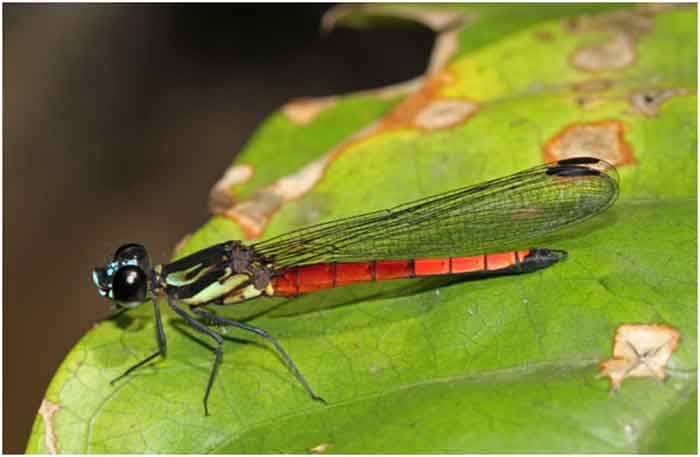
Africocypha varicolor red/ André Günther
As children in Bangalore we always found dragonflies in the garden. Catching them by their papery wings we would cruelly tie strings to their tails. Seeing them sail about the garden with the strings trailing behind them, set us off into paroxysms of childish laughter. Those wonderful icons of our childhood which were found in abundance across the world are now on the IUCN Red List. Is there anything we humans can leave to live alongside us?
The destruction of wetlands is driving the decline of dragonflies worldwide, according to the first global assessment of these species in today’s update of the IUCN Red List of Threatened Species Their decline is symptomatic of the widespread loss of the marshes, swamps and free-flowing rivers they breed in, mostly driven by the expansion of unsustainable agriculture and urbanisation around the world.
With today’s update, the number of species at risk of extinction on the Red List has exceeded 40,000 for the first time. The IUCN Red List now includes 142,577 species of which 40,084 are threatened with extinction.
“By revealing the global loss of dragonflies, today’s Red List update underscores the urgent need to protect the world’s wetlands and the rich tapestry of life they harbour. Globally, these ecosystems are disappearing three times faster than forests,” said Dr Bruno Oberle, IUCN Director General. “Marshes and other wetlands may seem unproductive and inhospitable to humans, but in fact they provide us with essential services. They store carbon, give us clean water and food, protect us from floods, as well as offer habitats for one in ten of the world’s known species.”
The assessment of the world’s dragonflies and damselflies reveals that 16% out of 6,016 species are at risk of extinction, as their freshwater breeding grounds increasingly deteriorate. In South and Southeast Asia, more than a quarter of all species are threatened, mostly due to the clearing of wetland and rainforest areas to make room for crops such as palm oil. In Central and South America, the major cause of dragonflies’ decline is the clearing of forests for residential and commercial construction. Pesticides, other pollutants and climate change are growing threats to species in every region of the world, and are the greatest threats to dragonflies in North America and Europe.
“Dragonflies are highly sensitive indicators of the state of freshwater ecosystems, and this first global assessment finally reveals the scale of their decline. It also provides an essential baseline we can use to measure the impact of conservation efforts,” said Dr Viola Clausnitzer, Co-chair of the IUCN SSC Dragonfly Specialist Group. “To conserve these beautiful insects, it is critical that governments, agriculture and industry consider the protection of wetland ecosystems in development projects, for example by protecting key habitats and dedicating space to urban wetlands.”
From research scientists have found that winged adult dragon flies consume adult mosquitoes, but they are short-lived, often lasting only a few weeks or months. They also rely on vision, which means they usually only hunt during the day, when most mosquitoes are not active.
In the naiad (aquatic nymph) stage, they might be more useful for controlling mosquito populations, as the naiads are voracious predators of mosquito larvae. It is also at this stage where dragonflies and damselflies spend most of their lifespans (usually a few years).
There have been successful field trials in the past (Venkatesh & Tyagi, 2012) for certain environments (like cement tanks or jars of water). But their effectiveness is still in question.
“Toyota is proud to have contributed to the global dragonfly assessment, the first insect group to be comprehensively assessed on the IUCN Red List,” said a spokesperson of Toyota Motor Corporation. “This achievement will make it possible to track progress in addressing biodiversity loss around the world.”
“Progress continues towards the Global Tree Assessment with many more tree assessments from across the world added in this update. Although the plight of many trees is serious, there is hope. Published in this update, Terminalia acuminata, a tree thought to be extinct in Brazil, has been rediscovered. Although the species is known from fewer than 300 mature individuals and is considered Endangered, this represents an exciting discovery and a chance to save this species before it is lost forever,” said Emily Beech, Tree Red List Manager at Botanic Gardens Conservation International.
“The plight of dragonflies is indicative of a wider crisis threatening many wetland species. As the Red List Authority for birds, BirdLife International has documented worrying population declines in numerous wetland bird species in recent years. This year’s update sees the Maccoa Duck (Oxyura maccoa) of eastern and southern Africa uplisted from Vulnerable to Endangered, due to pollution, entanglement in fishing nets and drainage of wetlands for agriculture,” said Dr Ian Burfield, Global Science Coordinator (Species), BirdLife International.
“Wetlands are of broad societal interest because of the many services they provide humans, but those services would not exist if not for the habitat wetlands provide for many endangered species,” said Dr Sean T. O’Brien, President and CEO of Nature Serve. O’Brien continued, “Our own wellbeing is inextricably connected to that of the natural world, and we must work together to find solutions that rectify the loss of habitat suffered by dragonflies and other essential indicator species.”
“The decline of the world’s wetlands impacts not only fish and aquatic plants, but also aquatic insects like dragonflies and damselflies. Beyond this, the loss of these critical habitats will have severe impacts on amphibians and migratory birds globally. Wetlands contain exceptional levels of biodiversity in an extremely small land area, and must receive the highest priority when designating new Key Biodiversity Areas. The loss of wetlands will have a disproportionate impact worldwide,” said Dr. Thomas E. Lacher, Jr., Professor Emeritus at Texas A&M University.
“Despite the 2019 IPBES report making it abundantly clear that nature deterioration needs to be urgently addressed, we are still to witness the transformative changes required for governments around the world to become nature positive,” said Dr Nathalie Pettorelli, ZSL Senior Scientist. “Addressing the rapid erosion of our natural capital is not something that can wait; it’s not something optional; it’s not something we can just ignore. Wildlife is our key ally to tackle the numerous societal challenges we face, including the existential threat posed by climate change.”
( Former Assistant Editor Deccan Herald, Adjunct faculty, St. Joseph’s PG College of Media Studies, Mount Carmel’s College for Women,Jyothi Nivas College for Women)
















































